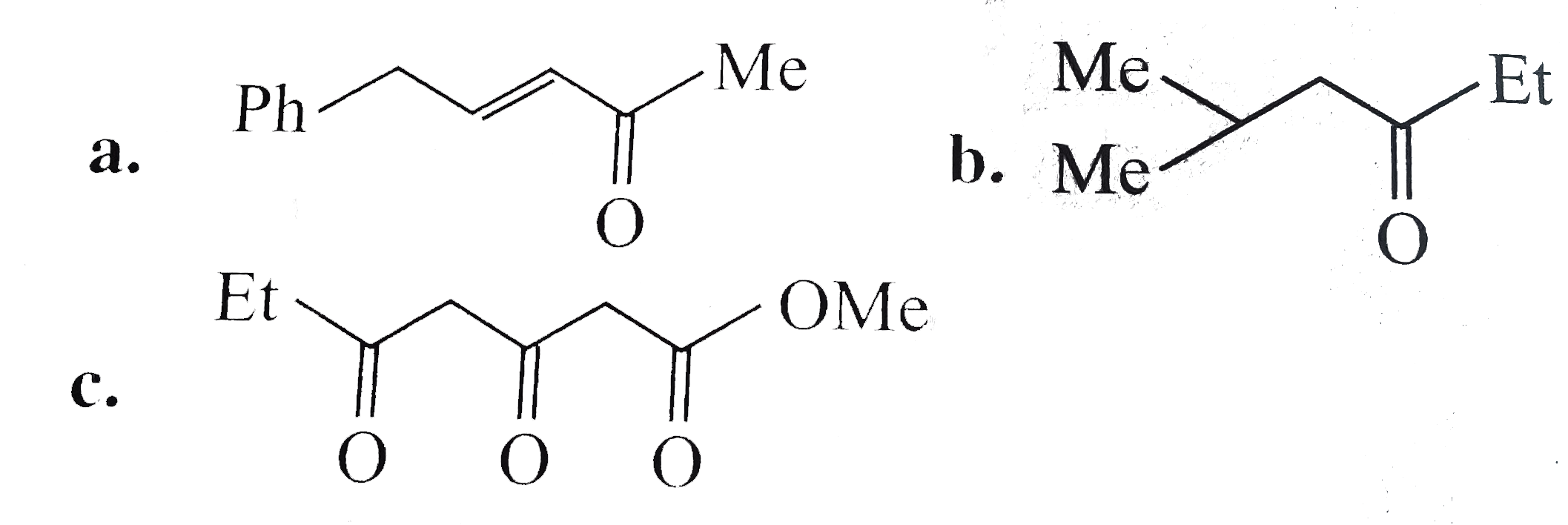The compound oxidised to prepare methyl ethyl ketone is
2-Propanol
1-Butanol
2-Butanol
t-Butyl alcohol.
The correct Answer is:C
To determine the compound that is oxidized to prepare methyl ethyl ketone (MEK), we need to identify the appropriate alcohol that, upon oxidation, yields MEK. Here’s the step-by-step solution:
Step 1: Understand the structure of Methyl Ethyl Ketone
Methyl ethyl ketone (MEK) has the following structure:
- It is a ketone with the formula C4H8O.
- The structure can be represented as CH3COC2H5, where one side has a methyl group (CH3) and the other side has an ethyl group (C2H5).
Step 2: Identify potential alcohols that can be oxidized
We will consider common alcohols that could potentially be oxidized to form MEK:
1. 2-Propanol (isopropanol)
2. 1-Butanol
3. 2-Butanol
Step 3: Analyze each alcohol for oxidation
- 2-Propanol:
- Structure: CH3CHOHCH3
- Upon oxidation, it converts to acetone (CH3COCH3), which does not have the ethyl group, so this is not the correct answer.
- 1-Butanol:
- Structure: CH3CH2CH2CHOH
- Upon oxidation, it converts to butanal (an aldehyde), which also does not yield a ketone. Therefore, this is not the correct answer.
- 2-Butanol:
- Structure: CH3CH(OH)CH2CH3
- Upon oxidation, it converts to methyl ethyl ketone (CH3COC2H5), which matches our target compound. Hence, this is the correct answer.
Conclusion
The compound oxidized to prepare methyl ethyl ketone is 2-butanol.
---
Methyl ethyl ketone (MEK) has the following structure:
- It is a ketone with the formula C4H8O.
- The structure can be represented as CH3COC2H5, where one side has a methyl group (CH3) and the other side has an ethyl group (C2H5).
We will consider common alcohols that could potentially be oxidized to form MEK:
1. 2-Propanol (isopropanol)
2. 1-Butanol
3. 2-Butanol
- 2-Propanol:
- Structure: CH3CHOHCH3
- Upon oxidation, it converts to acetone (CH3COCH3), which does not have the ethyl group, so this is not the correct answer.
- Structure: CH3CH2CH2CHOH
- Upon oxidation, it converts to butanal (an aldehyde), which also does not yield a ketone. Therefore, this is not the correct answer.
- Structure: CH3CH(OH)CH2CH3
- Upon oxidation, it converts to methyl ethyl ketone (CH3COC2H5), which matches our target compound. Hence, this is the correct answer.
The compound oxidized to prepare methyl ethyl ketone is 2-butanol.
Topper's Solved these Questions
- ALDEHYDES, KETONES AND CARBOXYLIC ACIDSBook:ICSEChapter:ALDEHYDES, KETONES AND CARBOXYLIC ACIDSExercise:EXERCISE (PART-II DESCRIPTIVE QUESTIONS) (VERY SHORT QUESTIONS)
Explore 282 Videos
- ALDEHYDES, KETONES AND CARBOXYLIC ACIDSBook:ICSEChapter:ALDEHYDES, KETONES AND CARBOXYLIC ACIDSExercise:EXERCISE (PART-II DESCRIPTIVE QUESTIONS) ( SHORT QUESTIONS)
Explore 581 Videos
- ALDEHYDES, KETONES AND CARBOXYLIC ACIDSBook:ICSEChapter:ALDEHYDES, KETONES AND CARBOXYLIC ACIDSExercise:EXERCISE (PART-II DESCRIPTIVE QUESTIONS) ( LONG ANSWER QUESTIONS)
Explore 478 Videos
- ALCOHOLS, PHENOLS AND ETHERS Book:ICSEChapter:ALCOHOLS, PHENOLS AND ETHERS Exercise:ISC EXAMINATION QUESTIONS
Explore 25 Videos
- APPENDIX II ( TYPICAL CONVERSIONS)Book:ICSEChapter:APPENDIX II ( TYPICAL CONVERSIONS)Exercise:AROMATIC CONVERSIONS
Explore 98 Videos
Similar Questions
Knowledge Check
Which of the following compounds is isomeric with
methyl vinyl ether?APropanalB1-propanolCEthyl methyl etherDDiethyl EtherThe reaction of ethyl methyl ketone with Cl2/excessOH− gives the following major product
AClCH2CH2COCH3BCH3CH2COCCl3CClCH2CH2COCH2ClDCH3CCl_(2)COCH2Cl
How would you prepare ethene from ethyl iodide
View SolutionThe compound on dehydrogenation gives a ketone. The original compound is :
View SolutionHow is acetone prepared from methyl cyanide?
View SolutionWhich alcohol is prepared from the following ketones via MPV reduction?

View SolutionThe most effective pair of reagents for the preparation of tert bytyl ethyl ehter is :
View SolutionThe compound 1- (N-ethyl-N-methyl)- propanamine forms non-superimposable mirror images . But this compound does not show optical activity because of the :
View Solution